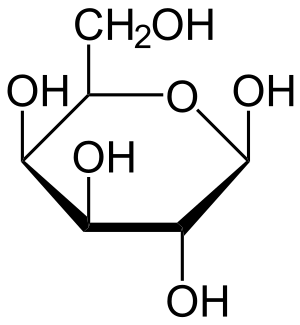Galactose
Galactose (/ɡəˈlæktoʊs/, galacto- + -ose, "milk sugar") sometimes abbreviated Gal, is a monosaccharide sugar that is about as sweet as glucose, and about 65% as sweet as sucrose.[2] It is an aldohexose and a C-4 epimer of glucose.[3] A galactose molecule linked with a glucose molecule forms a lactose molecule.
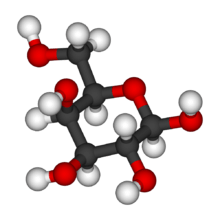 | |||
| |||
| Identifiers | |||
|---|---|---|---|
3D model (JSmol) |
|||
| ChEBI | |||
| ChEMBL | |||
| ChemSpider | |||
| KEGG | |||
| MeSH | Galactose | ||
PubChem CID |
|||
| UNII | |||
| |||
| |||
| Properties | |||
| C6H12O6 | |||
| Molar mass | 180.156 g·mol−1 | ||
| Appearance | White solid[1] | ||
| Odor | Odorless[1] | ||
| Density | 1.5 g/cm3[1] | ||
| Melting point | 168–170 °C (334–338 °F; 441–443 K)[1] | ||
| 650 g/L (20 °C)[1] | |||
| -103.00·10−6 cm3/mol | |||
| Pharmacology | |||
| V04CE01 (WHO) V08DA02 (WHO) (microparticles) | |||
| Hazards | |||
| NFPA 704 (fire diamond) | |||
Except where otherwise noted, data are given for materials in their standard state (at 25 °C [77 °F], 100 kPa). | |||
| Infobox references | |||
Galactan is a polymeric form of galactose found in hemicellulose, and forming the core of the galactans, a class of natural polymeric carbohydrates.[4]
Etymology
The word galactose was coined by Charles Weissman[5] in the mid 19th century and is derived from Greek galaktos (milk) and the generic chemical suffix for sugars -ose.[6] The etymology is comparable to that of the word lactose in that both contain roots meaning "milk sugar". Lactose is a disaccharide of galactose plus glucose.
Structure and isomerism
Galactose exists in both open-chain and cyclic form. The open-chain form has a carbonyl at the end of the chain.
Four isomers are cyclic, two of them with a pyranose (six-membered) ring, two with a furanose (five-membered) ring. Galactofuranose occurs in bacteria, fungi and protozoa,[7][8] and is recognized by a putative chordate immune lectin intelectin through its exocyclic 1,2-diol. In the cyclic form there are two anomers, named alpha and beta, since the transition from the open-chain form to the cyclic form involves the creation of a new stereocenter at the site of the open-chain carbonyl. In the beta form, the alcohol group is in the equatorial position, whereas in the alpha form, the alcohol group is in the axial position.[9]
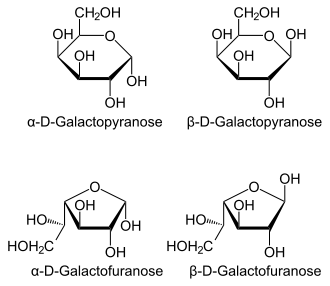
Relationship to lactose
Galactose is a monosaccharide. When combined with glucose (monosaccharide), through a condensation reaction, the result is the disaccharide lactose. The hydrolysis of lactose to glucose and galactose is catalyzed by the enzymes lactase and β-galactosidase. The latter is produced by the lac operon in Escherichia coli.
In nature, lactose is found primarily in milk and milk products. Consequently, various food products made with dairy-derived ingredients can contain lactose.[10] Galactose metabolism, which converts galactose into glucose, is carried out by the three principal enzymes in a mechanism known as the Leloir pathway. The enzymes are listed in the order of the metabolic pathway: galactokinase (GALK), galactose-1-phosphate uridyltransferase (GALT), and UDP-galactose-4’-epimerase (GALE).
In human lactation, glucose is changed into galactose via hexoneogenesis to enable the mammary glands to secrete lactose. However, most lactose in breast milk is synthesized from galactose taken up from the blood, and only 35±6% is made from galactose from de novo synthesis.[11] Glycerol also contributes some to the mammary galactose production.[12]
Metabolism
| Metabolism of common monosaccharides and some biochemical reactions of glucose |
|---|
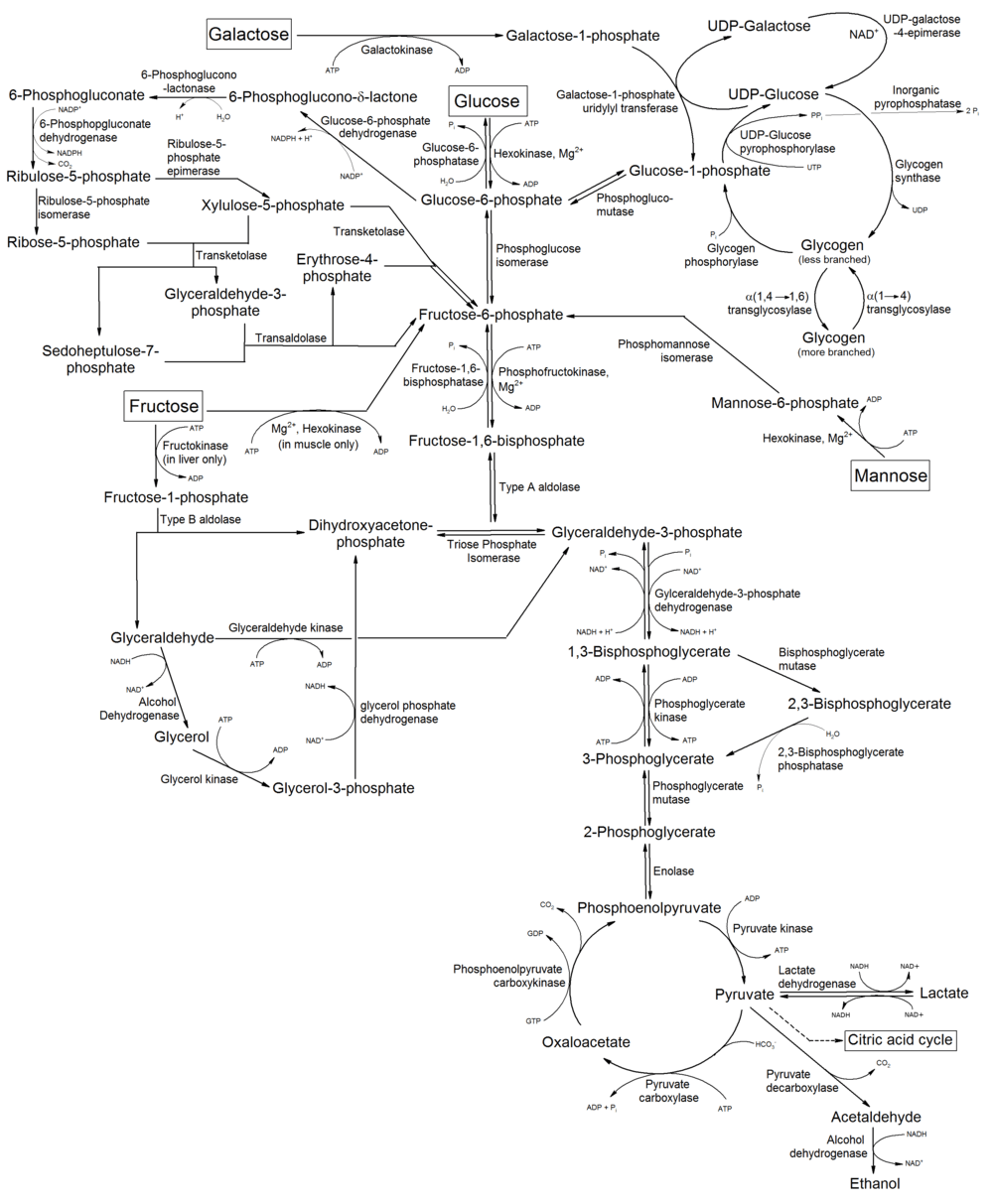 |
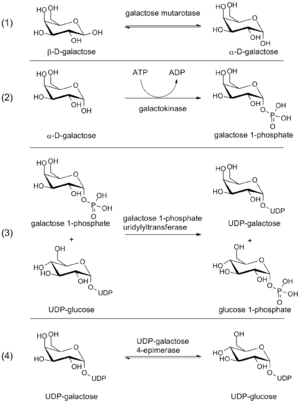
Glucose is more stable than galactose and is less susceptible to the formation of nonspecific glycoconjugates, molecules with at least one sugar attached to a protein or lipid. Many speculate that it is for this reason that a pathway for rapid conversion from galactose to glucose has been highly conserved among many species.[13]
The main pathway of galactose metabolism is the Leloir pathway; humans and other species, however, have been noted to contain several alternate pathways, such as the De Ley Doudoroff Pathway. The Leloir pathway consists of the latter stage of a two-part process that converts β-D-galactose to UDP-glucose. The initial stage is the conversion of β-D-galactose to α-D-galactose by the enzyme, mutarotase (GALM). The Leloir pathway then carries out the conversion of α-D-galactose to UDP-glucose via three principal enzymes: Galactokinase (GALK) phosphorylates α-D-galactose to galactose-1-phosphate, or Gal-1-P; Galactose-1-phosphate uridyltransferase (GALT) transfers a UMP group from UDP-glucose to Gal-1-P to form UDP-galactose; and finally, UDP galactose-4’-epimerase (GALE) interconverts UDP-galactose and UDP-glucose, thereby completing the pathway.[14]
Galactosemia is an inability to properly break down galactose due to a genetically inherited mutation in one of the enzymes in the Leloir pathway. As a result, the consumption of even small quantities is harmful to galactosemics.[15]
Sources
Galactose is found in dairy products, avocados, sugar beets, other gums and mucilages. It is also synthesized by the body, where it forms part of glycolipids and glycoproteins in several tissues; and is a by-product from the third-generation ethanol production process (from macroalgae).
Clinical significance
Chronic systemic exposure of mice, rats, and Drosophila to D-galactose causes the acceleration of senescence (aging). It has been reported that high dose exposure of D-galactose (120 mg/Kg) can cause reduced sperm concentration and sperm motility in rodent and has been extensively used as an aging model.[16][17][18] Two studies have suggested a possible link between galactose in milk and ovarian cancer.[19][20] Other studies show no correlation, even in the presence of defective galactose metabolism.[21][22] More recently, pooled analysis done by the Harvard School of Public Health showed no specific correlation between lactose-containing foods and ovarian cancer, and showed statistically insignificant increases in risk for consumption of lactose at 30 g/day.[23] More research is necessary to ascertain possible risks.
Some ongoing studies suggest galactose may have a role in treatment of focal segmental glomerulosclerosis (a kidney disease resulting in kidney failure and proteinuria).[24] This effect is likely to be a result of binding of galactose to FSGS factor.[25]
Galactose is a component of the antigens present on blood cells that determine blood type within the ABO blood group system. In O and A antigens, there are two monomers of galactose on the antigens, whereas in the B antigens there are three monomers of galactose.[26]
A disaccharide composed of two units of galactose, galactose-alpha-1,3-galactose (alpha-gal), has been recognized as a potential allergen present in mammal meat. Alpha-gal allergy may be triggered by lone star tick bites.
History
In 1855, E. O. Erdmann noted that hydrolysis of lactose produced a substance besides glucose.[27][28]
Galactose was first isolated and studied by Louis Pasteur in 1856 and he called it "lactose".[29] In 1860, Berthelot renamed it "galactose" or "glucose lactique".[30][31] In 1894, Emil Fischer and Robert Morrell determined the configuration of galactose.[32]
See also
References
- Record in the GESTIS Substance Database of the Institute for Occupational Safety and Health
- Spillane WJ (2006-07-17). Optimising Sweet Taste in Foods. Woodhead Publishing. p. 264. ISBN 9781845691646.
- Kalsi PS (2007). Organic Reactions Stereochemistry And Mechanism (Through Solved Problems). New Age International. p. 43. ISBN 9788122417661.
- Zanetti M, Capra DJ (2003-09-02). The Antibodies. CRC Press. p. 78. ISBN 9780203216514.
- "Charles Weismann in the 1940 Census". Ancestry. Retrieved 26 December 2017.
- Bhat PJ (2 March 2008). Galactose Regulon of Yeast: From Genetics to Systems Biology. Springer Science & Business Media. ISBN 9783540740155. Retrieved 26 December 2017.
- Nassau PM, Martin SL, Brown RE, Weston A, Monsey D, McNeil MR, et al. (February 1996). "Galactofuranose biosynthesis in Escherichia coli K-12: identification and cloning of UDP-galactopyranose mutase" (PDF). Journal of Bacteriology. 178 (4): 1047–52. doi:10.1128/jb.178.4.1047-1052.1996. PMC 177764. PMID 8576037.
- Tefsen B, Ram AF, van Die I, Routier FH (April 2012). "Galactofuranose in eukaryotes: aspects of biosynthesis and functional impact". Glycobiology. 22 (4): 456–69. doi:10.1093/glycob/cwr144. PMID 21940757.
- "Ophardt, C. Galactose". Archived from the original on 2006-09-08. Retrieved 2015-11-26.
- Staff (June 2009). "Lactose Intolerance – National Digestive Diseases Information Clearinghouse". digestive.niddk.nih.gov. Archived from the original on November 25, 2011. Retrieved January 11, 2014.
- Sunehag A, Tigas S, Haymond MW (January 2003). "Contribution of plasma galactose and glucose to milk lactose synthesis during galactose ingestion". The Journal of Clinical Endocrinology and Metabolism. 88 (1): 225–9. doi:10.1210/jc.2002-020768. PMID 12519857.
- Sunehag AL, Louie K, Bier JL, Tigas S, Haymond MW (January 2002). "Hexoneogenesis in the human breast during lactation". The Journal of Clinical Endocrinology and Metabolism. 87 (1): 297–301. doi:10.1210/jc.87.1.297. PMID 11788663.
- Fridovich-Keil JL, Walter JH. "Galactosemia". In Valle D, Beaudet AL, Vogelstein B, Kinzler KW, Antonarakis SE, Ballabio A, Gibson KM, Mitchell G (eds.). The Online Metabolic and Molecular Bases of Inherited Disease.
a 4 b 21 c 22 d 22 - Bosch AM (August 2006). "Classical galactosaemia revisited". Journal of Inherited Metabolic Disease. 29 (4): 516–25. doi:10.1007/s10545-006-0382-0. PMID 16838075.
a 517 b 516 c 519 - Berry GT (1993). "Classic Galactosemia and Clinical Variant Galactosemia". nih.gov. University of Washington, Seattle. Retrieved 17 May 2015.
- Pourmemar E, Majdi A, Haramshahi M, Talebi M, Karimi P, Sadigh-Eteghad S (January 2017). "Intranasal Cerebrolysin Attenuates Learning and Memory Impairments in D-galactose-Induced Senescence in Mice". Experimental Gerontology. 87 (Pt A): 16–22. doi:10.1016/j.exger.2016.11.011. PMID 27894939.
- Cui X, Zuo P, Zhang Q, Li X, Hu Y, Long J, Packer L, Liu J (August 2006). "Chronic systemic D-galactose exposure induces memory loss, neurodegeneration, and oxidative damage in mice: protective effects of R-alpha-lipoic acid". Journal of Neuroscience Research. 84 (3): 647–54. doi:10.1002/jnr.20899. PMID 16710848.
- Zhou YY, Ji XF, Fu JP, Zhu XJ, Li RH, Mu CK, et al. (2015-07-15). "Gene Transcriptional and Metabolic Profile Changes in Mimetic Aging Mice Induced by D-Galactose". PLOS One. 10 (7): e0132088. doi:10.1371/journal.pone.0132088. PMC 4503422. PMID 26176541.
- Cramer DW (November 1989). "Lactase persistence and milk consumption as determinants of ovarian cancer risk". American Journal of Epidemiology. 130 (5): 904–10. doi:10.1093/oxfordjournals.aje.a115423. PMID 2510499.
- Cramer DW, Harlow BL, Willett WC, Welch WR, Bell DA, Scully RE, Ng WG, Knapp RC (July 1989). "Galactose consumption and metabolism in relation to the risk of ovarian cancer". Lancet. 2 (8654): 66–71. doi:10.1016/S0140-6736(89)90313-9. PMID 2567871.
- Goodman MT, Wu AH, Tung KH, McDuffie K, Cramer DW, Wilkens LR, et al. (October 2002). "Association of galactose-1-phosphate uridyltransferase activity and N314D genotype with the risk of ovarian cancer". American Journal of Epidemiology. 156 (8): 693–701. doi:10.1093/aje/kwf104. PMID 12370157.
- Fung WL, Risch H, McLaughlin J, Rosen B, Cole D, Vesprini D, Narod SA (July 2003). "The N314D polymorphism of galactose-1-phosphate uridyl transferase does not modify the risk of ovarian cancer". Cancer Epidemiology, Biomarkers & Prevention. 12 (7): 678–80. PMID 12869412.
- Genkinger JM, Hunter DJ, Spiegelman D, Anderson KE, Arslan A, Beeson WL, et al. (February 2006). "Dairy products and ovarian cancer: a pooled analysis of 12 cohort studies". Cancer Epidemiology, Biomarkers & Prevention. 15 (2): 364–72. doi:10.1158/1055-9965.EPI-05-0484. PMID 16492930.
- De Smet E, Rioux JP, Ammann H, Déziel C, Quérin S (September 2009). "FSGS permeability factor-associated nephrotic syndrome: remission after oral galactose therapy". Nephrology, Dialysis, Transplantation. 24 (9): 2938–40. doi:10.1093/ndt/gfp278. PMID 19509024.
- McCarthy ET, Sharma M, Savin VJ (November 2010). "Circulating permeability factors in idiopathic nephrotic syndrome and focal segmental glomerulosclerosis". Clinical Journal of the American Society of Nephrology. 5 (11): 2115–21. doi:10.2215/CJN.03800609. PMID 20966123.
- Raven PH, Johnson GB (1995). Mills CJ (ed.). Understanding Biology (3rd ed.). WM C. Brown. p. 203. ISBN 978-0-697-22213-8.
- Erdmann EO (1855). Dissertatio de saccharo lactico et amylaceo [Dissertation on milk sugar and starch] (Thesis) (in Latin). University of Berlin.
- "Jahresbericht über die Fortschritte der reinen, pharmaceutischen und technischen Chemie" [Annual report on progress in pure, pharmaceutical, and technical chemistry] (in German). 1855. pp. 671–673. see especially p. 673.
- Pasteur L (1856). "Note sur le sucre de lait" [Note on milk sugar]. Comptes rendus (in French). 42: 347–351.
From page 348: Je propose de le nommer lactose. (I propose to name it lactose.)
- Berthelot M (1860). "Chimie organique fondée sur la synthèse" [Organic chemistry based on synthesis]. Mallet-Bachelier (in French). Paris, France. 2: 248–249.
- "Galactose" — from the Ancient Greek γάλακτος (gálaktos, “milk”).
- Fischer E, Morrell RS (1894). "Ueber die Configuration der Rhamnose und Galactose" [On the configuration of rhamnose and galactose]. Berichte der Deutschen chemischen Gesellschaft zu Berlin (in German). 27: 382–394. doi:10.1002/cber.18940270177. The configuration of galactose appears on page 385.
External links

